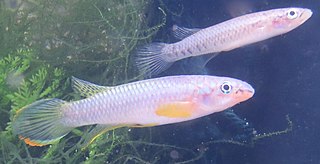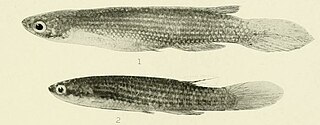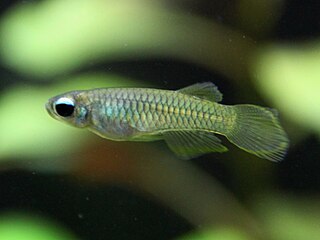
Poeciliidae are a family of freshwater ray-finned fishes of the order Cyprinodontiformes, the tooth-carps, and include well-known live-bearing aquarium fish, such as the guppy, molly, platy, and swordtail. The original distribution of the family was the Southeastern United States to north of Río de la Plata, Argentina, and Africa, including Madagascar. Due to release of aquarium specimens and the widespread use of species of the genera Poecilia and Gambusia for mosquito control, though, poeciliids can today be found in all tropical and subtropical areas of the world. In addition, Poecilia and Gambusia specimens have been identified in hot springs pools as far north as Banff, Alberta.

Nothobranchius is a genus of small, freshwater killifish, classified in the family Nothobranchiidae in the order Cyprinodontiformes. There are about a hundred species in the genus, many with very small distributions. They are primarily native to East Africa from Sudan to northern South Africa, whereas a dozen species are found in the upper Congo River Basin; the greatest species richness is in Tanzania.

Poecilia is a genus of fishes in the family Poeciliidae of the order Cyprinodontiformes. These livebearers are native to fresh, brackish and salt water in the Americas, and some species in the genus are euryhaline. A few have adapted to living in waters that contain high levels of toxic hydrogen sulfide and a population of P. mexicana lives in caves.

Steatocranus is a genus of small rheophilic cichlids mostly native to the Congo River Basin in DR Congo/Congo Brazzaville, although one species, S. irvinei, is restricted to the Volta River in Ghana and Burkino Faso, and it belongs in a separate genus. There are also at least c. 10 undescribed species in the Congo River basin awaiting scientific description.
Mastacembelus is a genus of many species of spiny eel fish from the family Mastacembelidae. They are native to Africa and Asia. Most are found in rivers and associated systems, but there are also species in other freshwater habitats and a particularly rich radiation is found in the Lake Tanganyika basin with 15 species. A few species can even occur in brackish water.

Chiloglanis is a genus of upside-down catfishes native to Africa. These species have modified lips and barbels that form a suckermouth. They also have a naked (scaleless) body. Sexual dimorphism has been reported in Chiloglanis. The adult males of many of these species have elongate anal and caudal fins. Also, males may have an enlarged humeral process.
The Lake Rukwa lampeye is a species of fish in the family Poeciliidae. Its natural habitats are intermittent rivers, freshwater marshes, and intermittent freshwater marshes. It is threatened by habitat loss. This species occurs in central Africa in Lake Rukwa, Tanzania, the Malagarasi River, Wembere River system and the upper basin of the Congo River. Its specific name honours the German physician and zoologist Friedrich Fülleborn (1866-1933), who collected the type.
Hypsopanchax is a genus of poeciliids native to freshwater habitats in Middle Africa.

Marcusenius is a genus of the elephantfish group native to Africa. Its members are highly diverse in size, with the smallest species reaching less than 15 cm (6 in) and the largest more than 1 m (3.3 ft).

Micropoecilia is a genus of poeciliids native to fresh and brackish water from the Amazon Basin to Trinidad. While recognized as valid by FishBase, others have considered this genus as being synonymous with Poecilia.

Nannocharax is a genus of distichodontid freshwater fishes found in Africa.

Notoglanidium is a genus of claroteid catfishes native to Africa. The formerly recognized genera Anaspidoglanis, Liauchenoglanis and Platyglanis have all been merged into Notoglanidium.

Aphyosemion is a genus of African rivulines endemic as the name indicates to Africa. Many of these species are popular aquarium fish.

Epiplatys is a genus of African rivuline in the family Nothobranchiidae endemic to Africa as the name indicates. Several of these species are popular aquarium fish.

Melanorivulus is a genus of South American freshwater fish in the family Rivulidae. Most species are endemic to the Río de la Plata, eastern Amazon, Tocantins–Araguaia and São Francisco basins in Brazil, but a few members of this genus range west into Bolivia, south into Paraguay and Argentina, and east to Parnaíba and Sergipe in northeastern Brazil. Only M. schuncki occurs north of the Amazon River. They inhabit shallow waters, generally 5–30 cm (2–12 in) deep, at the margins of streams in open or fairly open habitats like the Cerrado or Cerrado–Amazon transition. Many have tiny ranges and are seriously threatened.

Anablepsoides is a genus of killifish in the family Rivulidae native to tropical South America and the Lesser Antilles. The majority are from the Amazon and Orinoco basins, as well as freshwater systems in the Guiana Shield, but a few species are from northern Venezuela, northeastern Brazil and the Lesser Antilles. Although largely restricted to lowlands, a few species occur in the lower East Andean foothills. They are mostly found in shallow fresh water swamps, streams, edges of rivers, ponds and pools, but a few may occur in brackish estuaries. They are able to jump over land and breathe air for short periods, allowing them to access isolated waters inhabited by few or no other fish. Several Anablepsoides species have small distributions and some are seriously threatened by habitat loss; the entire known range of A. xinguensis is in the area flooded by the Belo Monte Dam.

Enteromius is a genus of small to medium-sized cyprinid fish native to tropical Africa. Most species were placed in the genus Barbus.

Procatopodinae is a subfamily of the family Poeciliidae, the "livebearers", in the order Cyprinodontiformes. Some authorities treat this subfamily as a family, the Procatopodidae, including the banded lampeye.

Poropanchax normani, also known as the Norman's lampeye, is a species of procatopodine fish which is native to Africa. It belongs to the group of African lampeyes and livebearers (Poeciliidae).
Béla Nagy, a Hungarian independent researcher, specialized in the seasonal killifish genus Nothobranchius, as well as members of the family Procatopodidae, both of them within the order Cyprinodontiformes.















